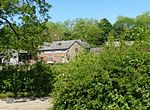Astley Green Colliery Museum
AC with 0 elementsCoal mines in LancashireMining in LancashireMining museums in EnglandMuseums in Greater Manchester ... and 5 more
Railway museums in EnglandScheduled monuments in Greater ManchesterTourist attractions in the Metropolitan Borough of WiganUnderground mines in EnglandUse British English from July 2017

The Astley Green Colliery Museum is a museum run by the Red Rose Steam Society in Astley near Tyldesley in Greater Manchester, England. (grid reference SJ70509996) Before becoming a museum, the site was a working colliery that produced coal from 1912 to 1970; it is now protected as a Scheduled Monument. The museum occupies a 15-acre (6 ha) site by the Bridgewater Canal which has the only surviving pit headgear and engine house on the Lancashire Coalfield.
Excerpt from the Wikipedia article Astley Green Colliery Museum (License: CC BY-SA 3.0, Authors, Images).Astley Green Colliery Museum
Geographical coordinates (GPS) Address Nearby Places Show on map
Geographical coordinates (GPS)
| Latitude | Longitude |
|---|---|
| N 53.4953 ° | E -2.4473 ° |
Address
M29 7JA
England, United Kingdom
Open on Google Maps







